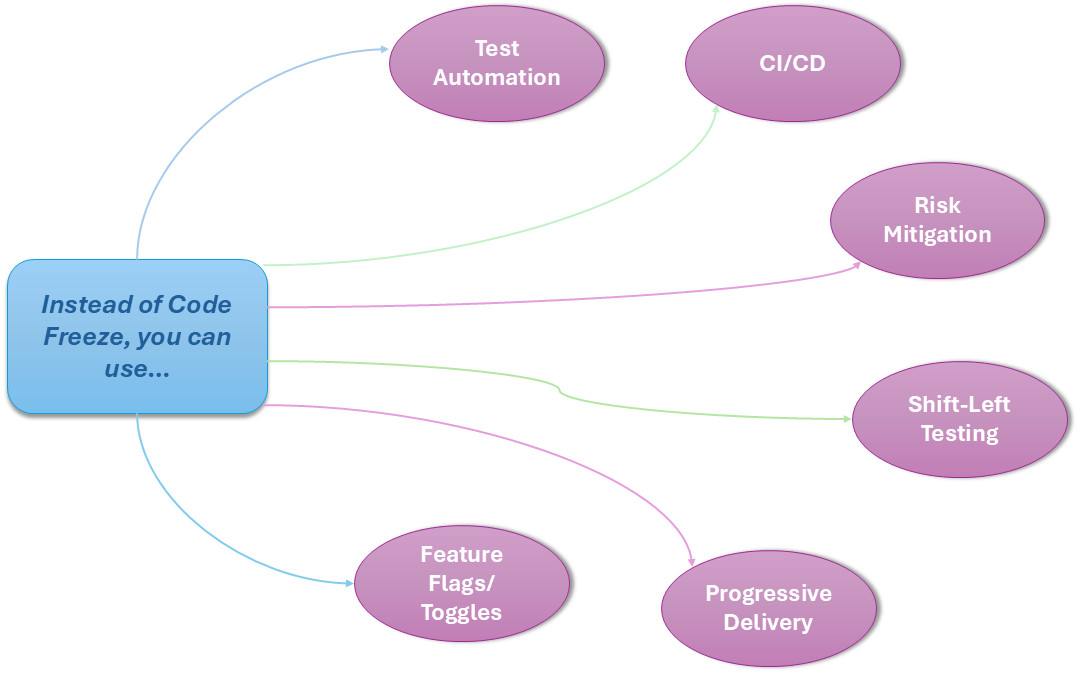What is Code Freeze and is it Relevant Today?
|
|
Ever been part of a software release cycle where, at a certain point, new features stop, major changes are put on hold, and the focus shifts entirely to stability? This is what a “Code Freeze” looks like.
For those who don’t know, a code freeze is simply a period during a software development lifecycle when no new code changes or features are supposed to be added into the main code repository. Only blocker bug fixes are allowed, and even those typically need special approval.
For years, it was routine, a kind of necessary step to make sure of quality ahead of a major launch. However, in an era characterized by Agile methodologies, DevOps culture, and continuous delivery, a legitimate question arises: Is the idea of a code freeze applicable anymore? Or is it more of an antiquated relic that does more harm than good?
Let’s learn more about this practice and its relevance in today’s times.
| Key Takeaways: |
|---|
|

What is a Code Freeze?
So, what does a “code freeze” really mean?
It’s not just a suggestion; it’s a requirement. A code freeze practically halts feature developments and refactoring efforts on the feature branch dedicated to the upcoming release.
This duration varies from a couple of days to a few weeks, depending on project complexity and organizational release cycle. The breadth can also change, sometimes including feature branches and sometimes the entire repository.
The sole exceptions typically made are exceptions for critical bug fixes – problems that must be fixed in order to release – and even processes for these tend to be fairly formalized to make sure nothing slips in that also happens to bring new problems with it.
The primary goals behind implementing a code freeze are straightforward and, at first glance, logical:
- Stabilize the Codebase for Release: By preventing new code from entering, the team aims to create a fixed target for testing.
- Provide a Dedicated Window for Final Testing and Bug Fixing: QA teams get an undisturbed environment to perform extensive regression testing and verify fixes.
- Reduce the Risk of Introducing New Defects Close to Launch: The idea is to avoid last-minute changes that could destabilize the application right before it goes live.
- Create a Predictable Release Environment: A frozen codebase is meant to make the release process more controlled and less prone to unexpected issues.
Code freezes are quite useful in development methodologies like the Waterfall, where changes get deployed like big, rare icebergs. They were particularly common for large monolithic applications with tight coupling between parts, or around large product launches, when any problem could drive serious business damage.
The logic was simple: shut down everything, get it all right, and then go.
Why was Code Freeze Adopted?
To understand why code freeze became so ubiquitous, we need to understand the historical context in which it emerged. It was generally regarded as a necessary evil for a long time, the one you take in order to control the inherent uncertainties in software development.
One of the key drivers was to mitigate risk. Building software in the old, less mature development environments was like a mystery. Big, sporadic releases meant that there were a lot of changes to ship all at once, making it possible for bugs and unintended side effects to slip through. A code freeze was a safeguard, a time to stop and thoroughly inspect what was new before it was opened for users. It was a matter of minimizing the risk of an unmitigated disaster on launch day.
This led directly to a strong quality assurance focus. With a frozen codebase, QA teams finally had a stable target. They could perform extensive, often manual, regression testing, knowing that the underlying code wouldn’t shift beneath their feet. This dedicated testing window was seen as essential for ensuring the product met quality standards before going live. It allowed for a concentrated effort to find and fix bugs without the moving target of ongoing development.
Furthermore, in complex projects, especially those with many interdependencies between different modules or teams, code freeze helped with dependency management. By stopping changes across the board, it simplified coordination and reduced the chances of one team’s new feature inadvertently breaking another’s. It created a clear, shared understanding of what was being released and minimized surprises from concurrent development efforts.
This approach had its origins in historical development models, such as the Waterfall. In the Waterfall model, the development stages move linearly through the requirements, design, implementation, testing, and deployment phases. Perfectly fitting in this linear flow, we added a so-called “code freeze” as a milestone towards the transition from the implementation phase to the dedicated testing and stabilizing phase ahead of going live. It was a natural checkpoint in a process designed to make sure predictability and control around large infrequent releases.
Challenges and Drawbacks of Code Freeze in Agile
When we talk about code freeze, what used to make sense in the name of prudence can now often seem like a bottleneck.
Perhaps the most significant issue is reduced agility and flexibility. The very essence of Agile and DevOps is rapid iteration, continuous feedback, and the ability to respond quickly to market changes or user needs. A code freeze, by definition, brings this to a grinding halt. It contradicts the principles of continuous delivery, where code is always in a releasable state, and forces teams into a rigid, sequential process that no longer fits the demands of today’s dynamic software landscape.
This rigidity often leads to increased pressure and stress for development teams. The “big bang” approach of a large, infrequent release, preceded by a freeze, creates immense pressure to cram all remaining work and fixes into a shrinking window. This can result in last-minute rushes, hurried decisions, and developer burnout, especially when critical issues are discovered late in the freeze.
Another major consequence is delayed releases and slower time-to-market. New features, even if completed, must wait for the current release’s freeze to lift and the next cycle to begin. This means missed opportunities, as competitors might launch similar features faster, or user demands go unaddressed for longer periods. In a competitive market, speed is paramount, and code freezes are a direct impediment to that.
The practice can also contribute to the accumulation of technical debt. Non-critical fixes, refactoring, or minor improvements are often postponed until “after the freeze.” This creates a growing backlog of technical debt that can slow down future development, make the codebase harder to maintain, and eventually lead to more significant problems down the line.
The discovery of “frozen” bugs is a particularly frustrating scenario. When critical bugs are found deep within the code freeze period, they can cause significant delays. Fixing them often means “unfreezing” parts of the code, introducing new risks, and potentially leading to a cascading effect of further testing and even re-freezes, pushing the release date back even further.
Furthermore, code freezes can lead to the ineffective use of resources. Developers who have completed their work for the current release might find themselves idle during the freeze, or assigned to less impactful tasks, simply because they aren’t allowed to commit new code to the main branch. This represents a significant waste of valuable talent and time.
And ultimately, depending on a code freeze can lull you into a false sense of security. The saying “it is stable because it is frozen” can be quite harmful. A freeze doesn’t make the bugs disappear or even really guarantee quality; it just postpones the problem. Even if the development and testing processes upon which it’s based are solid, a frozen codebase might have critical flaws that don’t get identified until it’s in production.
Is Code Freeze Relevant Today?
So, if code freeze was once the standard, why is its relevance being so heavily questioned today?
The answer lies in the fundamental shifts that have occurred in how we build and deliver software. Modern development paradigms prioritize speed, flexibility, and continuous flow, making traditional freezes feel like an archaic bottleneck.
At the forefront of this shift are Agile and Scrum methodologies. These approaches emphasize iterative development, breaking down large projects into smaller, manageable sprints. The focus is on continuous feedback, adapting to change, and delivering working software frequently. A code freeze fundamentally clashes with this philosophy, as it forces a halt in iteration and delays the delivery of value.
Hand-in-hand with Agile is the rise of DevOps culture. DevOps aims to bridge the gap between development and operations, building collaboration and automating processes across the entire software delivery lifecycle. The core tenets of DevOps revolve around continuous improvement, monitoring, and, crucially, continuous delivery. A code freeze directly contradicts the idea of a seamless, automated pipeline where code flows effortlessly from development to production.
This brings us to Continuous Integration (CI) and Continuous Delivery (CD) / Continuous Deployment. CI is about integrating code changes frequently into a shared repository, with automated builds and tests running to detect issues early. CD extends this by ensuring that the software can be released to production at any time, while Continuous Deployment takes it a step further by automatically deploying every change that passes all automated tests. In these environments, releases become routine, low-risk events, making a dedicated “freeze” period unnecessary and counterproductive. The entire pipeline is designed to maintain a releasable state continuously.
The architectural landscape has also evolved. The move from monolithic applications to Microservices Architecture means that large, interdependent systems are broken down into smaller, independently deployable services. This decoupling significantly reduces the need for an organization-wide code freeze, as changes to one service don’t necessarily impact others, allowing for independent deployment cycles.
Finally, practices like Feature Flags/Toggles have revolutionized how features are deployed. Instead of waiting for a full release, new features can be deployed to production in a disabled state. They can then be enabled or disabled independently, often for specific user segments, without requiring a new deployment. This dramatically reduces the risk associated with introducing new functionality and eliminates the need for a freeze to “stabilize” features before they are exposed to users.
In essence, modern development paradigms are built on the premise of constant motion and continuous validation. A code freeze, by its very nature, is a pause – and in today’s fast-moving software world, a pause often means falling behind.
What are the Alternatives to Code Freeze?
Given the challenges and the evolution of development methodologies, what are the modern alternatives to a code freeze?
The answer lies in embracing continuous practices that integrate quality and stability throughout the development lifecycle, rather than trying to impose it at the end.
A cornerstone of this approach is robust automated testing. This isn’t just about having some automated tests; it’s about building comprehensive test suites that run continuously. This includes unit tests to validate individual code components, integration tests to make sure different parts of the system work together, end-to-end tests to simulate real user journeys, and performance tests to check scalability and responsiveness. When these tests run automatically with every code change, they provide immediate feedback, catching issues long before a “freeze” would have.
This emphasis on early detection is part of a broader movement called Shift-Left Testing. Instead of waiting for a dedicated QA phase, testing activities are integrated much earlier into the development lifecycle. Developers write tests as they code, and automated checks are part of the very first stages of development, ensuring quality is built in from the ground up.
The backbone of continuous delivery is Continuous Integration/Continuous Delivery (CI/CD) Pipelines. These automated pipelines are designed to build, test, and deploy code automatically whenever changes are committed. Every successful commit triggers a series of automated checks, providing rapid validation and ensuring that the codebase is always in a releasable state. This eliminates the need for a separate stabilization period.
Effective code management also plays a crucial role. Practices like Feature Branching allow teams to manage code changes efficiently. Feature branching enables developers to work on new features in isolation, merging them back into the main branch only when they are complete and validated.
For managing risk during deployment, teams are increasingly adopting Progressive Delivery techniques. This includes strategies like Canary Releases, where new versions are rolled out to a small subset of users first, and A/B Testing, which allows different versions of a feature to be presented to different user groups to gather data and feedback. These methods enable gradual rollouts, minimizing the impact of any unforeseen issues and providing a safety net that a blanket code freeze once attempted to offer.
Finally, Observability and Monitoring in production are critical. Modern applications are instrumented to provide real-time insights into their health and performance. This means that even after deployment, teams can quickly detect and respond to issues, often before they impact a significant number of users. This continuous feedback loop from production further reduces the reliance on pre-release freezes.

How testRigor Improves Release Readiness
testRigor is designed to empower teams to achieve the stability and confidence that a code freeze aimed for, but without the associated bottlenecks and drawbacks. It does this by making automated testing incredibly efficient, reliable, and accessible to everyone on the team.
One of testRigor’s standout features is its codeless automation. This means that tests are written in plain English, not complex code. Anyone, from business analysts to manual testers to product managers, can create and understand tests. This dramatically speeds up test creation and makes sure that test cases accurately reflect real user journeys, eliminating the need for specialized automation engineers to be a bottleneck during critical periods.
This codeless approach directly translates into speed and efficiency. Teams can achieve rapid test creation, quickly build comprehensive test suites for new features as soon as they are developed, and easily expand regression suites. These tests can be executed with incredible speed, running thousands of tests in minutes. This provides immediate feedback on every code change, allowing developers to identify and fix issues while they are still small and inexpensive to resolve, long before any thought of a “code freeze” would even cross their minds.
testRigor addresses the biggest pain point of traditional test automation: maintainability and stability. Its self-healing tests automatically adjust to minor UI changes, such as element re-positioning or attribute changes. This drastically reduces the notorious test maintenance burden that often plagues automated suites, especially in continuous delivery environments where UI changes are frequent. The result is stable regression suites that consistently provide reliable results, ensuring that as new code is integrated, existing functionality remains intact without constant test rewrites.
With testRigor, teams can achieve comprehensive coverage, testing complex end-to-end user journeys across various platforms, browsers, and devices. This broad coverage ensures that the entire application is validated, not just isolated components.
Also, testRigor is built to integrate seamlessly with CI/CD pipelines. It can be easily hooked into existing development workflows, ensuring that every code commit automatically triggers relevant tests. This means continuous validation, providing an immediate safety net, and eliminating the need for a separate “stabilization” phase.
By providing immediate, reliable test results, testRigor enables an early feedback loop. Issues are identified much earlier in the development cycle, shifting quality left and eliminating the need for a dedicated “stabilization” period that a code freeze represents. Developers get instant alerts if their changes break anything, allowing for quick corrections.
With this tool, you can transform releases from high-stress, infrequent events into routine, low-risk operations.
The Future is Flowing, Not Frozen
So, what’s the takeaway from all of this?
The industry has undergone a significant paradigm shift. We have moved from a sequential, “big bang” release model to one that champions continuous, automated, and collaborative development practices. The focus is no longer on halting progress to achieve stability, but on integrating quality and confidence into every step of the development pipeline. While code freeze certainly serves a purpose, maybe as a branch freeze, one cannot halt all parts of the SDLC in today’s dynamic, agile world. You might need the code freeze approach for big-ticket items, but relying solely on code freeze isn’t a great idea anymore. You need to find better ways to manage the release risks (maybe by reducing the delivery rate in some scenarios). However, you can minimize these risks with better test automation and CI practices, and also use code freeze, but only sparingly.
| Achieve More Than 90% Test Automation | |
| Step by Step Walkthroughs and Help | |
| 14 Day Free Trial, Cancel Anytime |












